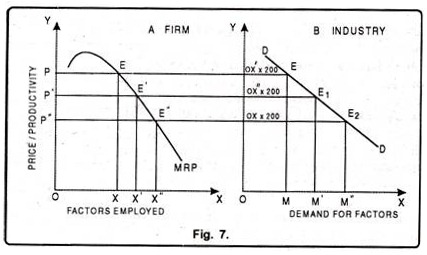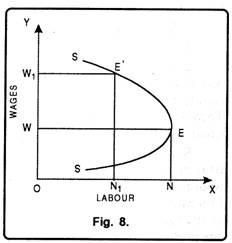Modern Theory of Distribution: Meaning, Assumptions, Demand for Factors of Production and Other Details!
Meaning:
The modern theory of factor pricing provides a satisfactory explanation of the problem of distribution.
It is known as the demand and supply theory of distribution. According to the modem theory of factor pricing, the equilibrium factor prices can be explained by the forces of demand and supply.
Prices paid for productive services are like any other price and they are basically determined by demand and supply conditions. Incomes are received as payments for the services of factors of production. Wages are payments for the services rendered by labour.
ADVERTISEMENTS:
Rents are payments for the services of land and interest is payment for the services of capital. In this way most incomes are remunerations or prices paid for services rendered by factors of production in the process of production. This theory is superior to the marginal productivity theory, because it takes into account both the forces of demand and supply in the determination of factor prices. Marshall held the view that no separate theory is required to explain factor prices. The principles which govern commodity pricing also govern factor-pricing. The following paragraphs touch upon the salient aspects of the theory.
“The theory of factor prices is just a special case of the theory of price. We first develop a theory of the demand for factors, then a theory of the supply of factors and finally combine them into a theory of determination of equilibrium price and quantities.” Lipsey and Stonier
Assumptions:
1. Every producer tries to get maximum profit.
2. Producers have perfect knowledge of the MRP
ADVERTISEMENTS:
3. Active competition exists in the factor market.
4. There is active competition among the different units of factors.
5. The state does not intervene to equate the prices of the factor service.
Demand for Factors of Production:
The demand for factors of production is different from that of the demand for goods. The demand for goods is direct while the demand for factors of production is derived demand. The factors of production are demanded because they assist the process of production. Productivity of a factor refers to the contribution made by it in the process of production. If the demand for goods which the factor produces is more, its own demand will also be high and vice-versa. The elasticity of demand for industry with identical costs will be high.
ADVERTISEMENTS:
It means that the total demand of a factor unit at OP price level is OM i.e. OX’ x 200. Further, at price level OP’, the demand is OM’ = (OX” X 200) and so on. Now, by taking all the possible combinations of factors price and the total demand for it we can draw the demand curve DD for the whole industry. In Figure, the factor price is determined by the quantity of the factor, possibility of substitutes, and elasticity of demand for final product. Thus, the demand for the factor is determined by its marginal revenue productivity.
The total demand for the factor in an industry, the demand for the factors by all the firms has to be added. It can be shown with the following fig. 7:
Factors Affecting Demand:
The demand for factors is influenced by the following factors:
(a) The Elasticity of Demand for the Final Product:
The demand for the services of a factor will be elastic if a slight fall in its price brings about a large responsiveness in its employment. Since the demand for the factor service is a derived demand, the elasticity of demand for the final product will determine the elasticity of demand for the factor service.
(b) The Amount of Factor Required:
The elasticity of demand for the factor service also depends upon the extent to which the factor service in question is required in the production of the commodity. If the factor service plays an insignificant role, then, demand for it would be inelastic i.e., demand for the factor service will not be affected by a change in the price.
(c) Substitutability:
Elasticity of demand for a factor service also depends upon the extent to which factor service in question can be substituted by other factors “The greater the ease with which factors of production can be substituted for each other, the more elastic is likely to be the demand for them.
Supply of Factors of Production:
Like the demand for factors of production, supply of factors of production also differs from that of the goods. The supply of goods increases with the increase in price. But in the ease of factors of production, there exists no simple relation between supply and price. But for the sake of our convenience, we presuppose that there exists the positive relation between supply and price. It cannot be unrealistic because the higher prices attract the factors to work more.
Factors Affecting Supply:
The main factors responsible for affecting supply of factors of production are as under:
1. Supply of Land:
ADVERTISEMENTS:
For an economy, supply of land is perfectly inelastic. Supply of land is free for an economy because it has no case of production. But for an industry, supply of land depends on opportunity cost. If opportunity cost of land increases in one industry as compared to another industry then more of it will be used in the former industry than the latter. Thus, for an industry supply curve will be upward sloping.
2. Supply of Labour:
Supply of labour refers to the number of hours for which a labourer is willing to sell his services at a given price. There exists no definite relation between supply of labour and wage rate. Ordinarily, it is opined that up to a limit supply of labour increases with increase in wage. But after a given level, as the wage rate increases labour prefers leisure to work. In this situation, supply curve becomes backward sloping as seen in fig. 8.
In Fig. 8 SS is backward sloping supply curve of labour. It shows that up to OW wage rate supply of labourer is increasing but when wage rate rises from OW to OW] then supply of labour decreases from ON to ON1,
3. Supply of Capital:
ADVERTISEMENTS:
Supply of capital depends on savings. Price of capital is called interest. According to classical economists with the increase in rate of interest, supply of savings will increase and vice-versa. Thus, supply curve of capital will slope upward.
4. Supply of Entrepreneur:
There exists no definite relation between supply of entrepreneur and his price. Besides profits, supply of an entrepreneur depends on many non-economic factors.

